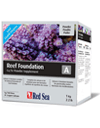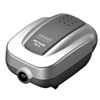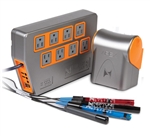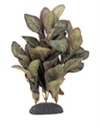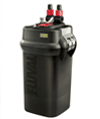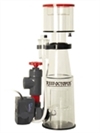Aquarium Pump Overview
Choosing a Main System Aquarium Water Pump
The critical choices when choosing a pump are:
- Powerhead or pump. A power head is submersible pump and a pump is an external pump. Some pumps, such as the Pondmaster pumps can be used submersed or externally.
- Connections. All of our pumps list the diameters of the input and outlets. You always want to use a pump with an outlet diameter that is equal to or less than the diameter of the hose and all other fittings before the water is returned to the tank or sump. For example, if you use 3/4" hose with a pump with a 1" output, you will severely restrict the flow of the pump.
- Flow rate. All of our pumps have the flow rate listed in gph (gallons per hour). The flow rate will be affected by the amount of head pressure. Consult the
Head Pressure and Pump Performance section below for information on determining how much head pressure you will have. Once you've determined the head pressure, you can use the performance charts listed for most of pumps to determine how much output in gph you will have.
Aquarium Water Pump Desired Flow Rate
The optimum tank "turnover rate" is approximately 6 to 7 times per hour for saltwater fish-only tanks, 10 to 15 times per hour for saltwater reef tanks and 4 to 5 times for freshwater tanks. For example, the pumps on a 50 gallon reef tank should be a total of 500 to 600 gph (after head pressure is taken into account). When determining which pumps you needs to achieve your desired flow rate you should include all the pumps in your system. This includes the powerheads in the tank and any pumps running power filters and canister filters. Although your protein skimmer pump may have significant flow, since protein skimmers have a great deal of head pressure you will not get much flow from your protein skimmer pump.
To determine how much flow you will get from any given pump, you can calculate the head pressure (the calculation is provided below) and refer to the performance charts provided for most pumps. To see an example of how head pressure effects gph view the
Performance Chart for the Rio Aqua Pumps. Head pressure is listed as "MAX. HEAD".
Aquarium Water Pump
Head Pressure and Pump PerformanceAs the head pressure increases the gph will decrease. Use the following guide to determine the amount of head pressure in your application in order to determine how much flow you will get from any pump.
- Each 90-degree bend in the plumbing will add about one foot of head due to friction. Each 45-degree bend will add 1/2 foot head pressure. This includes any bends in filters, chillers and uv sterilizers.
- As a result of friction, each 10-foot horizontal run of pipe will add a foot of head pressure.
- In an open system (a system using a sump), each foot of vertical distance from the intake of the pump to the return into the aquarium will add one foot of head pressure. The vertical distance in a closed system does not affect head pressure. A closed system is one where the pump draws water directly from the aquarium and returns water directly to the aquarium.
Using the example of the
Performance Chart for the Rio Aqua Pumps, if the distance from the inlet of the aquarium pump to the discharge point in the display tank were five feet and there were two 90 degree bends in the plumbing and five feet of horizontal pipe, then the head pressure would be approx. 7.5 feet.
As seen in the Rio Aqua Pumps chart, there is a limit to the head an aquarium pump can handle. With the Rio 600 when the head feet reaches 4, the gph is reduced to zero. Most of our pumps have listed the head height where the Shut Off point is reached.
Note: We have not included any info for how much head pressure there is when you restrict the flow by using hose or return fittings with a smaller diameter than the pump outlet. This depends on the size of the pump outlet and the amount of restriction. In general, it increases head pressure a great deal and is not advisable.
Aquarium Water Pump RedundancyYou'll be better off with two or more smaller pumps than one large
pump. Having at least some water turnover is critical to the survival
of any aquarium, and if you have more than one pump when a pump fails
you will not need to desperately locate a replacement pump. An aquarium
can completely crash within eight hours if there is no water turnover because pumps are critical to aeration. An air pump will keep an
aquarium aerated--you may want to have a battery operated air pump
on hand to keep your aquarium operational during power outages.
Aquarium Water Pump Noise
We are often asked if a particular pump is noisy. In general, pump noise is a function of the output of the pump and how the pump is hooked up. Most pump noise is caused by the pump vibration causing attached hard surfaces to vibrate, and by friction as the water travels from the pump. To reduce pump noise you will want to do the following:
- Put the pump on a padded surface to absorb the pump vibration
- Use flexible hose
- Use as few plumbing pieces as possible
- When connecting an external pump to a sump, use flexible hose to connect the sump bulkhead to the pump inlet
- Do not restrict the inlet of a pump by using a plumbing fitting with a smaller diameter than the pump inlet. This will cause cavitation as well as a great deal of noise
Even if you follow all the bullet-pointed advice listed above, you will still have some pump noise. With smaller pumps this will not be very noticeable, but with bigger pumps it can be irritating in a quiet environment.
Aquarium Water Pump Cost
"The best advice I can offer is this: Even if you are on a tight budget, do not scrimp on the pump. This is the most important component of the system, and its failure can spell disaster."
John H. Tullock, "Natural Reef Aquariums"







